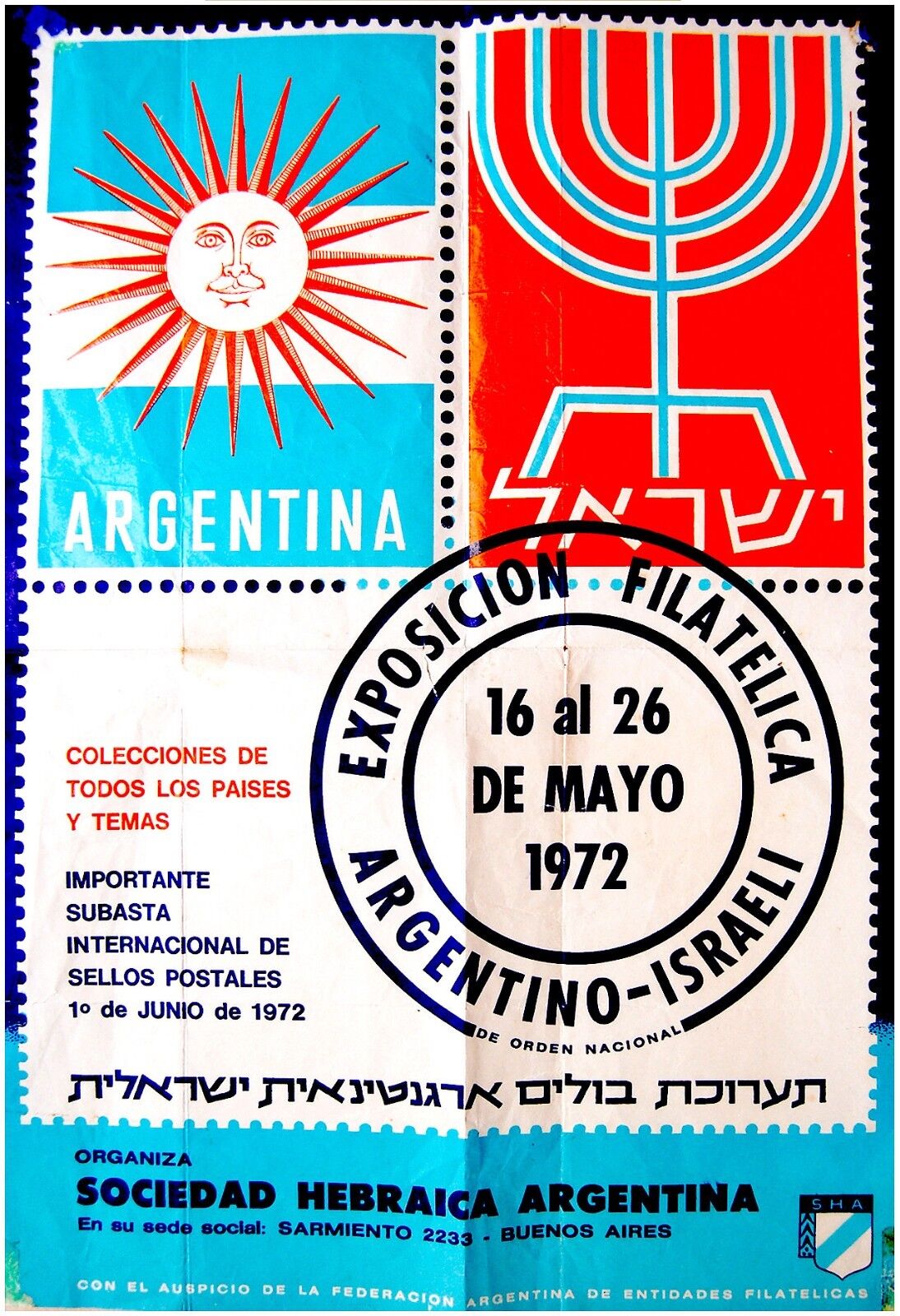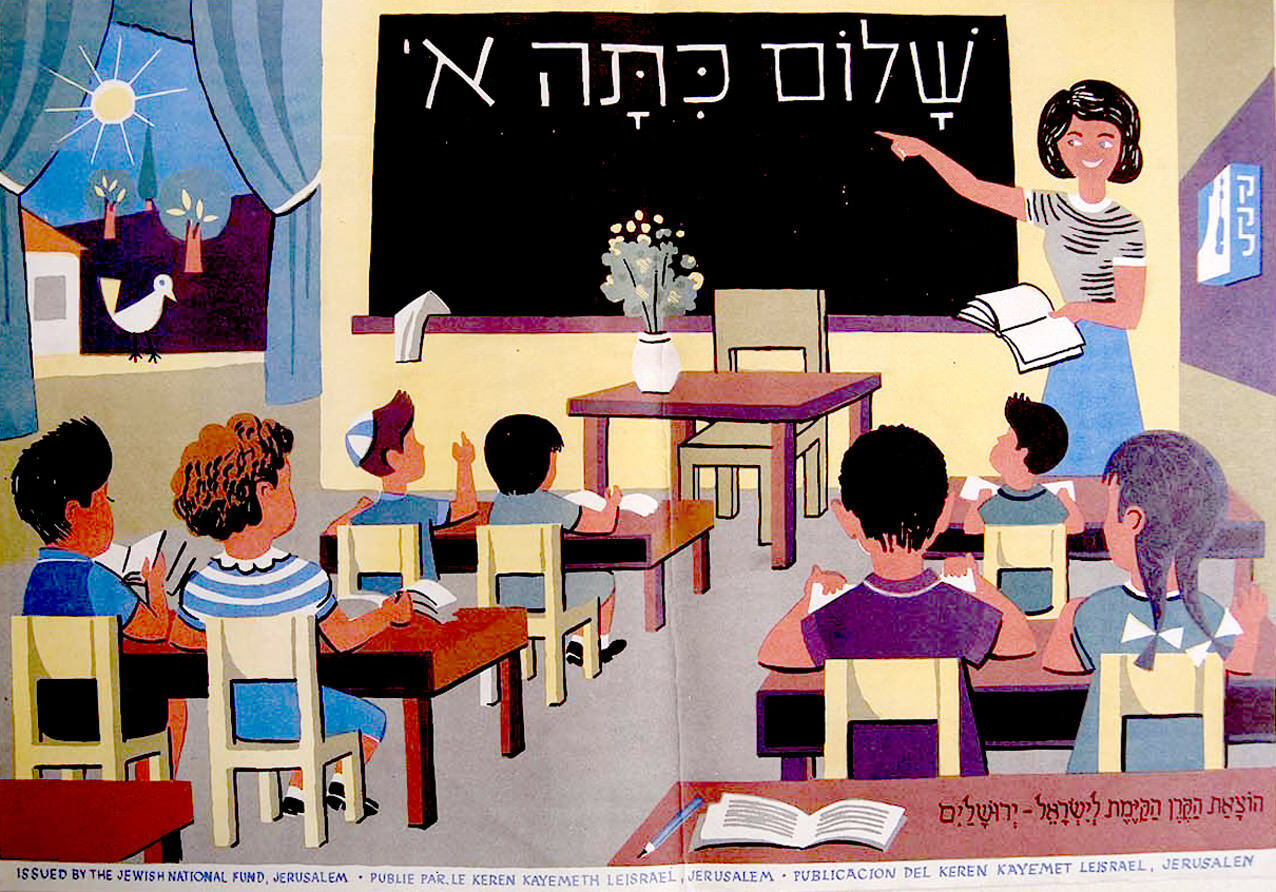-40%
VINTAGE Judaica PHILATELIC POSTER Israel JEWISH MENORAH Argentina STAMPS & FLAG
$ 29.28
- Description
- Size Guide
Description
DESCRIPTION:
Here for sale is a genuine authentic vintage
over
40 years old JEWISH POSTER , Which was issued in BUENOS AIRES ARGENTINA for the purpose of advertising, Promoting, celebrating and commemorating a joint PHILATELIC EXHIBITION of ARGENTINA and ISRAEL which was arranged in 1972 by the Jewish Association in Argentina. . The poster depicts among other things, a nicely illustrated LARGE image of
a JEWISH MENORAH
(also
חַנֻכִּיָּה
hanukiah, or chanukkiyah )
side by side with a graphic design of the Argenina flag , the typical Argentinian smiling SUN IMAGE .
A colorful Printing . The poster SIZE is around 18" x 13" . Quite good condition. Folded. Slight imperfections at corners where the poster was previously held to the wall by tapes.
( Pls look at scan for accurate AS IS images )
The POSTER will be sent rolled in a special protective rigid sealed tube.
PAYMENTS
:
Payment method accepted : Paypal .
SHIPPING
:
Shipp worldwide via registered airmail is $ 25 . Poster will be sent rolled in a special protective rigid sealed tube.
Handling around 5 days after payment.
The Hanukkah menorah (Hebrew:
מנורת חנוכה
m'noraht khanukkah
, pl.
menorot
) (also Hebrew:
חַנֻכִּיָּה
hanukiah, or chanukkiyah, pl.
hanukiyot
/
chanukkiyot
, or Yiddish:
חנוכּה לאמפּ
khanike lomp
, Hanukkah lamp) is, strictly speaking, a nine-branched candelabrum lit during the eight-day holiday of Hanukkah, as opposed to the seven-branched menorah used in the ancient Temple or as a symbol. The ninth holder, called the
shamash
("helper" or "servant"), is for a candle used to light all other candles and/or to be used as an extra light. The menorah is among the most widely produced articles of Jewish ceremonial art. The seven-branched menorah is a traditional symbol of Judaism, along with the Star of David. Hanukkah Hebrew:
חֲנֻכָּה
, Tiberian:
Ḥănukkāh
, usually spelled
חנוכה
, pronounced
[χanuˈka]
in Modern Hebrew; a transliteration also romanized as Chanukah, Chanukkah or Chanuka), also known as the Festival of Lights and Feast of Dedication, is an eight-day Jewish holiday commemorating the rededication of the Holy Temple (the Second Temple) in Jerusalem at the time of the Maccabean Revolt against the Greeks of the 2nd century BCE. Hanukkah is observed for eight nights and days, starting on the 25th day of Kislev according to the Hebrew calendar, which may occur at any time from late November to late December in the Gregorian calendar. The festival is observed by the kindling of the lights of a unique candelabrum, the nine-branched
Menorah
or
Hanukiah
, one additional light on each night of the holiday, progressing to eight on the final night. The typical Menorah consists of eight branches with an additional raised branch. The extra light is called a
shamash
(Hebrew:
שמש
, "attendant") and is given a distinct location, usually above or below the rest. The purpose of the
shamash
is to have a light available for practical use, as using the Hanukkah lights themselves for purposes other than publicizing and meditating on the Hanukkah is forbidden. The Jewish National Fund (Hebrew:
קרן קימת לישראל
,
Keren Kayemet LeYisrael
) (abbreviated as JNF, and sometimes KKL) was founded in 1901 to buy and develop land in Ottoman Palestine (later British Mandate for Palestine, and subsequently Israel and the Palestinian territories) for Jewish settlement. The JNF is a quasi-governmental, non-profit organization.By 2007, it owned 13% of the total land in Israel. Since its inception, the JNF has planted over 240 million trees in Israel. It has also built 180 dams and reservoirs, developed 250,000 acres (1,000 km) of land and established more than 1,000 parks.In 2002, the JNF was awarded the Israel Prize for lifetime achievement and special contribution to society and the State of Israel. The JNF was founded at the Fifth
Zionist Congress
in
Basel
in 1901 with
Theodor Herzl
's support based on the proposal of a German Jewish mathematician,
Zvi Hermann Schapira
. Early land purchases were completed in Judea and the Lower Galilee. In 1909, the JNF played a central role in the founding of
Tel Aviv
. The establishment of the “Olive Tree Fund” marked the beginning of Diaspora support of afforestation efforts. The Blue Box (known in Yiddish as a
pushke
) has been part of the JNF since its inception, symbolizing the partnership between Israel and the Diaspora. In the period between the two world wars, about one million of these blue and white tin collection boxes could be found in Jewish homes throughout the world.From 1902 until the late 1940s, the JNF sold JNF stamps to raise money. For a brief period in May 1948, JNF stamps were
used as postage stamps
during the transition from
Palestine
to Israel.The first parcel of land, 200 dunams (0.20 km) east of
Hadera
, was received as a gift from the Russian Zionist leader Isaac Leib Goldberg of Vilnius, in 1903. It became an olive grove. In 1904 and 1905, the JNF purchased land plots near the
Sea of Galilee
and at
Ben Shem
e
n
. In 1921, JNF land holdings reached 25,000 acres (100 km²), rising to 50,000 acres (200 km²) by 1927. At the end of 1935, JNF held 89,500 acres (362 km²) of land housing 108 Jewish communities. In 1939, 10% of the Jewish population of the British Mandate of Palestine lived on JNF land. JNF holdings by the end of the
British Mandate
period amounted to 936 km².By 1948, the JNF owned 54% of the land held by Jews in the region, or a bit less than 4% of the land in what was then known as Palestine. By the eve of statehood, the JNF had acquired a total of 936,000 dunums of land; another 800,000 dunums had been acquired by other Jewish organizations or individuals. Most of the JNF's activities during the Mandatory period were closely associated with
Yossef Weitz
, the head of its settlement department.By the eve of statehood, the JNF had acquired a total of 936,000 dunums of land; another 800,000 dunums had been acquired by other Jewish organizations or individuals.From the beginning, JNF's policy was to lease land long-term rather than sell it. In its charter, the JNF states: "Since the first land purchase in Eretz Israel in the early 1900s for and on behalf of the Jewish People, JNF has served as the Jewish People's trustee of the land, initiating and charting development work to enable Jewish settlement from the border in the north to the edge of the desert and Arava in the south."After
Israel's establishment
in 1948, the government began to sell
absentee
lands to the JNF. On January 27, 1949, 1,000 km² of land (from a total of about 3,500 km²) was sold to the JNF for the price of
I£
11 million. Another 1,000 km² of land was sold to the JNF in October 1950. Over the years questions about the legitimacy of these transactions have been raised but Israeli legislation has generally supported the JNF's land claims.In 1953, the JNF was dissolved and re-organized as an Israeli company under the name
Keren Kayemet LeYisrael
(JNF-KKL). In 1960, administration of the land held by the JNF-KKL, apart from forested areas, was transferred to a newly formed government agency, the
Israel Land Administration
(ILA). The ILA was then responsible for managing some 93% of the land of Israel. All the land managed by the ILA was defined as
Israeli lands
; it included both land owned by the government (about 80%) and land owned by the JNF-KKL (about 13%). The JNF-KKL received the right to nominate 10 of the 22 directors of the ILA, lending it significant leverage within that state body.After concentrating on the centre and northern part of the young state, the JNF-KKL started supporting Jewish settlements around the
Negev
border from around 1965. After the
Six-Day War
in 1967, the JNF-KKL started work in the newly occupied
Palestinian territories
as well. ebay2718
















